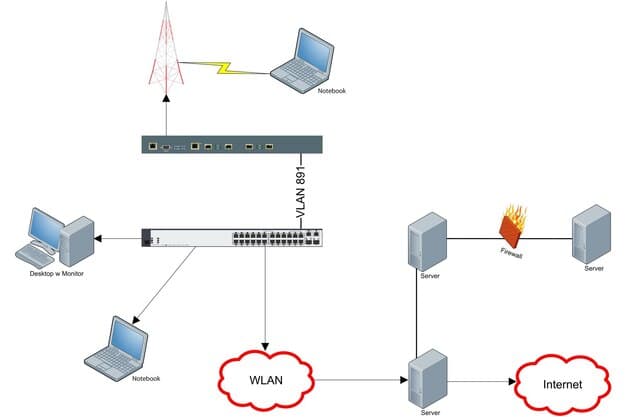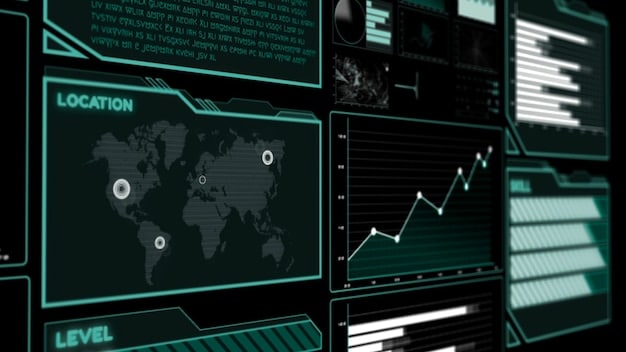Threat Hunting: Proactive Defense in the US Against Hidden Threats

Threat hunting involves proactively searching for cyber threats that evade traditional security measures in US environments, utilizing advanced techniques to identify and neutralize hidden risks before they cause significant damage.
Is your US-based organization truly secure? Traditional security measures often miss sophisticated, hidden threats. That’s where threat hunting: proactively searching for hidden threats in your US environment using advanced techniques comes in – a proactive strategy to seek out and neutralize these dangers before they can impact your business. Let’s explore how you can implement this critical practice.
What is Threat Hunting?
Threat hunting represents a paradigm shift from reactive security measures to a proactive stance. It’s about going beyond automated alerts and actively seeking out malicious activities that have bypassed initial defenses.
This proactive approach is vital because cybercriminals are constantly evolving their tactics. Relying solely on automated systems can leave organizations vulnerable to novel and sophisticated attacks.
The Core Principles of Threat Hunting
Threat hunting operates on several core principles that distinguish it from traditional security responses.
- Hypothesis-Driven Approach: Threat hunters start with a hypothesis about potential threats, guiding their investigation.
- Proactive Exploration: Unlike reactive incident response, threat hunting actively searches for threats before alerts trigger.
- Deep Analysis: Threat hunters employ in-depth analysis techniques to uncover hidden malicious activities.
Threat hunting is not simply about reacting to alerts; it’s about anticipating and discovering threats before they escalate into significant incidents.

Why is Threat Hunting Important for US Organizations?
In today’s threat landscape, US organizations face a constant barrage of cyberattacks. Threat hunting is becoming increasingly important to ensure that an organization’s security posture remains strong.
Many companies continue to use reactive measures despite threat actors evolving their methods. Threat hunting ensures that these new attack methods are found and dealt with.
Meeting Compliance Requirements
Many regulations, such as HIPAA and GDPR, require organizations to implement robust security measures. Threat hunting can help organizations meet these requirements by demonstrating a proactive approach to security.
Reducing Dwell Time
Dwell time, the period a threat remains undetected in a system, is a critical metric in cybersecurity. Threat hunting drastically reduces dwell time by actively seeking out and neutralizing threats.
- Lower dwell time means less time for attackers to cause damage.
- Faster detection reduces the scope and cost of remediation.
- Proactive measures prevent minor breaches from escalating into major incidents.
Threat hunting improves detection and drastically lowers the amount of time for attackers to cause damage.
Advanced Threat Hunting Techniques
The success of threat hunting hinges on the use of advanced techniques and tools. These methods enable threat hunters to uncover deeply hidden and sophisticated threats.
There are many different methods available to threat hunters, each with its own strengths and weaknesses. What may be useful in some cases may not be in others.
Behavioral Analysis
Behavioral analysis involves monitoring and analyzing user and system behaviors to identify anomalies that may indicate malicious activity. The goal is to establish a baseline of normal behavior and detect deviations.
Anomaly Detection
Anomaly detection focuses on identifying outliers or unusual events that deviate from established norms. AI and Machine Learning are used to analyze large datasets to spot patterns that warrant further investigation.
- Machine learning algorithms learn normal network behavior to identify deviations.
- Statistical analysis helps isolate outliers in log data and system metrics.
- User Entity and Behavioral Analytics (UEBA) tools provide deeper insights into user activities.
Anomaly analysis can save time, but is far from perfect on its own. It is important to have trained analysts who can follow up on findings to prevent future attacks.

Building a Threat Hunting Team
A successful threat hunting program requires a skilled team with diverse expertise. Each member has a unique skill set that they can bring to the team.
Building a threat hunting team involves selecting the right personnel, providing adequate training, and fostering a collaborative environment that promotes knowledge sharing and continuous learning.
Key Roles and Responsibilities
A threat hunting team typically consists of several key roles, each with specific responsibilities.
- Threat Hunters: Conduct proactive searches for threats, analyze data, and develop hypotheses.
- Security Analysts: Investigate alerts, respond to incidents, and provide support to threat hunters.
- Data Scientists: Develop and maintain data models, perform statistical analysis, and create visualizations.
- Incident Responders: Manage and contain security incidents, coordinate response efforts, and mitigate damage.
Every role is critical for the success of the threat hunting team to ensure that all responsibilities are covered.
Tools and Technologies for Threat Hunting
The effectiveness of threat hunting relies heavily on the tools and technologies used to gather, analyze, and interpret data. Choosing the right tools is crucial for enabling efficient and thorough threat hunts.
There are many different types of tools available with each providing its own unique benefits to threat hunters.
SIEM Systems
Security Information and Event Management (SIEM) systems are fundamental tools for threat hunting. They aggregate and analyze security data from various sources, providing a centralized view of an organization’s security posture.
Endpoint Detection and Response (EDR)
Endpoint Detection and Response (EDR) tools monitor endpoint activity in real time, providing visibility into processes, network connections, and user behaviors. EDR tools are essential for detecting threats at the endpoint level.
- Real-time monitoring of endpoint activities
- Automated threat detection and response
- Behavioral analysis to identify anomalies
EDR tools help provide constant monitoring of systems to ensure no malicious actions go unnoticed.
Overcoming Challenges in Threat Hunting
While threat hunting offers numerous benefits, organizations often face several challenges when implementing and maintaining a proactive threat hunting program. Understanding these challenges is essential for developing effective strategies to overcome them.
Organizations need to be aware of these challenges, so that they are not taken by surprise when they occur.
Lack of Visibility
Limited visibility into network traffic, endpoint activity, and user behavior can hinder threat hunting efforts. Without comprehensive data, threat hunters struggle to identify and investigate potential threats.
Skills Gap
Threat hunting requires specialized skills and expertise, including data analysis, threat intelligence, and incident response. Many organizations struggle to find and retain qualified threat hunters.
- Invest in training programs
- Partner with cybersecurity firms
- Foster a culture of continuous learning
Organizations should invest in training to ensure they are able to retain a skilled threat hunting team.
| Key Point | Brief Description |
|---|---|
| 🔍 Proactive Approach | Actively seeks out threats, unlike reactive security measures. |
| 🛡️ Reduced Dwell Time | Minimizes the time threats remain undetected, reducing potential damage. |
| 📊 Behavioral Analysis | Uses AI and machine learning to detect anomalies in user and system behavior. |
| 🛠️ SIEM and EDR | Employs tools like SIEM and EDR for data aggregation and real-time monitoring. |
What is threat hunting?
▼
Threat hunting is a proactive cybersecurity activity that involves actively searching for cyber threats that are present in an organization’s network, but have not been detected by traditional security systems.
▼
Threat hunting is crucial for US organizations because it helps uncover sophisticated threats that bypass standard security measures, ensuring compliance with regulations and reducing dwell time in the constantly evolving cybersecurity landscape.
▼
Threat hunters use a variety of techniques including behavioral analysis, anomaly detection, and reviewing threat intelligence feeds to identify malicious activity that has infiltrated a computer system.
▼
Threat hunters use a wide variety of tools to detect and analyze threats including; Security Information and Event Management (SIEM), Endpoint Detection and Response (EDR), and User and Entity Behavior Analytics (UEBA).
▼
Key skills for a threat hunter include a strong understanding of cybersecurity principles, expertise in data analysis, familiarity with various security tools, and good problem-solving skills. Good communication is also key.
Conclusion
Ultimately, threat hunting: proactively searching for hidden threats in your US environment using advanced techniques is essential for any organization seeking to bolster its cybersecurity posture. By adopting a proactive approach and investing in the right tools and skilled personnel, organizations can effectively defend against sophisticated threats and safeguard their critical assets.





